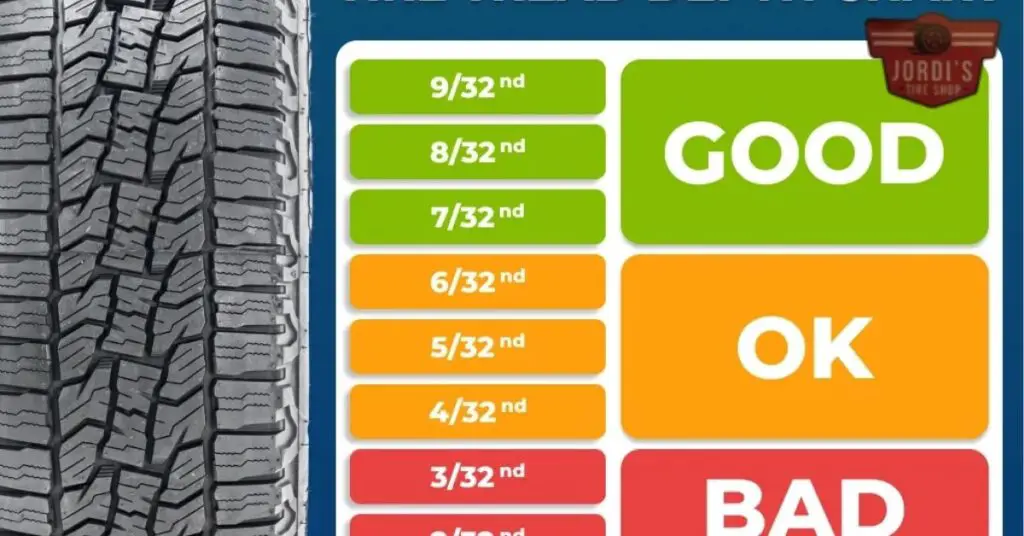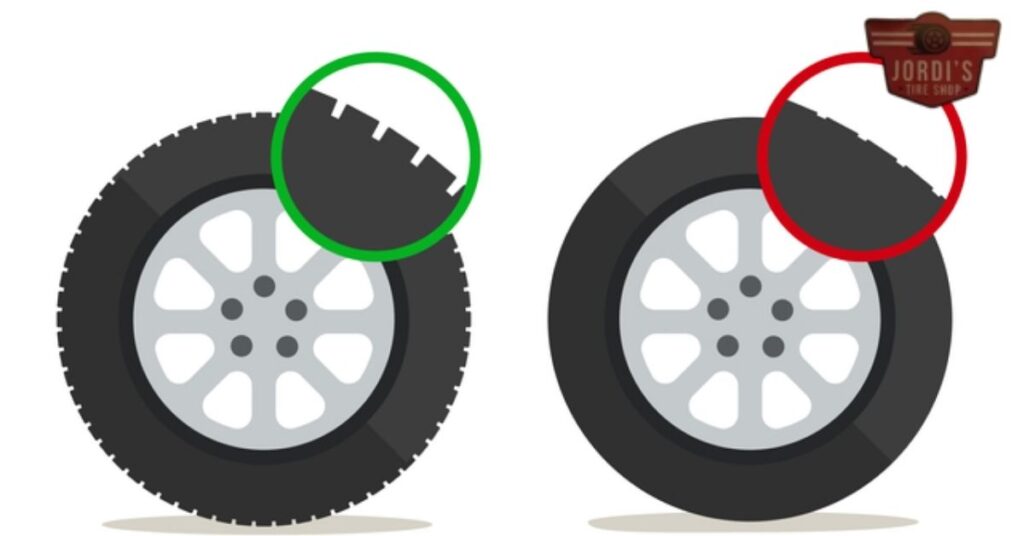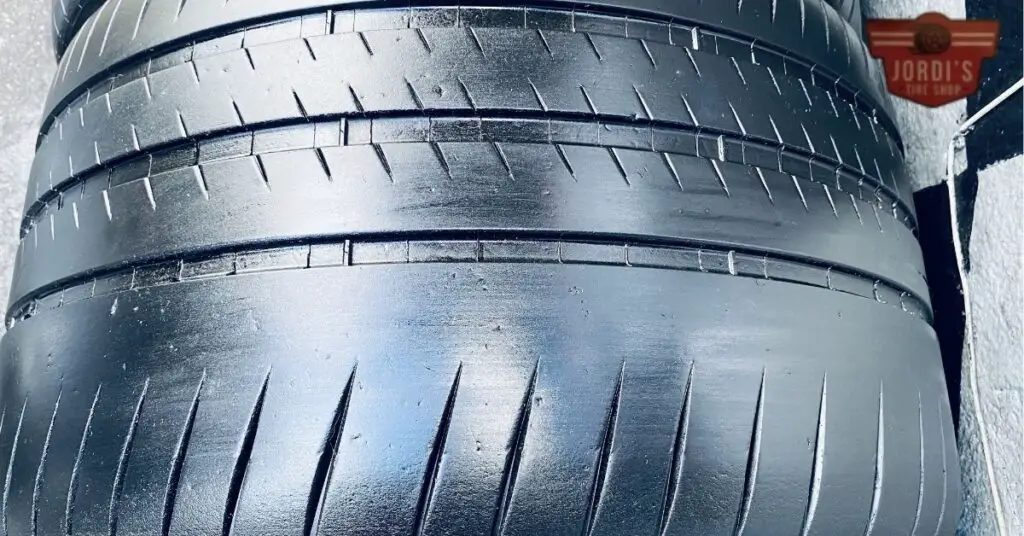Ever wondered what “7 32 tread” means when you’re shopping for new tires? You’re not alone. This seemingly cryptic code is actually a simple, yet crucial piece of information about your vehicle’s tires.
Understanding tire tread depth can be the difference between a safe drive and a potential disaster. It’s more than just numbers—it’s about your safety on the road.
Understanding the Concept of 7 32 Tread

Jump into the nitty-gritty of the term “7 32 tread” to unravel its significance when it comes to tire analysis. Grasp the necessity of comprehending such terminologies, especially those related to tread depth, as they are vital elements in road safety.
What Does 7 32 Tread Mean?
Often used in tire maintenance, 7/32-inch tread is an inch-based measurement representing the remaining depth of a tire tread. The number signifies that the distance between the top of the tire tread and its bottom is exactly 7/32 of an inch. If you’re considering buying new tires, you’ll commonly see tread depths advertised in this format.
Why Measuring Tread Depth is Important
Tread depth is no passing detail when it comes to tire safety. It significantly influences your car’s grip on the road, particularly in challenging conditions such as rainy weather or icy roads. When tire tread depth decreases, your car is more prone to hydroplaning, a situation where your car loses traction and slides uncontrollably. That’s why it’s advisable to regularly measure your tire’s tread depth. Not only is it an indicator of when you might require new tires, but it also provides further insight into your vehicle’s overall safety.
Evaluating the Performance of 7 32 Tread Tires

The performance of your 7/32 tread tires can vary based on different road and weather conditions. To ensure safe driving, it’s crucial to understand how these factors come into play.
On Different Road Conditions
A 7/32 tread tire might perform admirably on dry roads, demonstrating balanced grip and traction. These tires can hold up well under most standard driving conditions, producing a smooth ride with low noise level. But, when it comes to uneven or rough surfaces, they could show signs of instability, suggesting that tread depth plays an essential role in overall driving control.
Also, 7/32 tread tires might struggle on roads with loose material, such as gravel or sand. Here, higher tread depths usually offer superior road grip and better handling. So, understanding road conditions is essential in evaluating how long 7/32 tread tires will last before requiring replacement.
In Different Weather Conditions
When evaluating the performance of 7/32 tread tires in different weather conditions, it’s important to consider the impact of factors like rain, snow, or ice – as these can significantly influence traction control.
Even though 7/32 tread tires may maintain a decent performance in moderate rainfalls, the chance of hydroplaning, or losing control due to a layer of water between the tire and the road, increases in heavy rain or standing water.
Besides, on icy, snow-covered roads, these tires can find it challenging to obtain the necessary grip. They may not prove as efficient as winter tires, especially those with deeper treads. Conversely, during sunny and dry conditions, 7/32 tread tires often provide reliable and consistent performance, given decent road conditions.
Considering these facts, it’s useful to consider both road and weather conditions whilst assessing the performance of your 7/32 tread tires. This knowledge can alert you to the right time for inspecting and potentially replacing your tires, eventually improving overall vehicle safety.
The Lifespan of 7 32 Tread Tires
The lifespan of 7 32 tread tires heavily depends on many factors, resulting in variation from one case to another. You’ll gain an in-depth understanding of these variables in the sections below.
Factors Affecting the Longevity of 7 32 Treads
Several factors influence the longevity of your 7 32 tread tires. First, driving style plays a important role. For instance, frequent aggressive braking or acceleration might result in faster tread wear.
Secondly, the type of roads you frequently drive upon will also leave an impact on the tread life. Surprisingly, constant driving on rough, gravel roads might lead to more considerable wear as opposed to smooth, city roads.
Also, tire maintenance is vital. Regular tire rotations, proper tire pressure, and timely alignment checks contribute to a prolonged lifespan for your tires.
Finally, weather conditions can significantly affect tire longevity. Adverse conditions like heavy rain, snow, or excessively hot weather processes a fast wear on your tread; hence the tire lifespan decreases.
Every element stated, affects your tire’s lifespan in its unique flavor, enforcing that understanding and considering these factors will aid in maximizing your tire’s lifespan.
Comparing 7 32 Tread Tires with Other Treads

In the area of tire maintenance, understanding the impact of various tread depths on performance is crucial. Let’s investigate into how a 7/32 tread measures up against tires with higher and lower tread depths.
Comparison with Higher Tread Depths
Tires with tread depths greater than 7/32, such as 9/32 or 11/32 tread tires, exhibit pronounced improvements in gripping capabilities. Especially under severe weather conditions, these tires perform remarkably. For example, 9/32 tread tires equate to significantly decreased risk of hydroplaning in heavy rains or standing waters as compared to 7/32 tread tires.
Also, tires with higher tread depth like 11/32 provide substantial benefits in terms of handling snow or icy conditions, delivering optimum grip on such surfaces. On uneven terrains or loose materials like gravel, these tires, too, outshine 7/32-tread alternatives. Hence, in terms of safety and peak performance, tires with tread depths higher than 7/32 typically offer more robust answers.
But, these advantages come with increased tire weight and rolling resistance, which could lead to higher fuel consumption. It’s also important to note that deeper treads mean slower wear, which can extend tire lifespan. But, these tires might be pricier than their less tread counterparts.
Comparison with Lower Tread Depths
On the flip side, tires exhibiting lower tread depths, such as 5/32 or 3/32 tread tires, may not provide the same level of safety and performance under adverse conditions. For instance, 5/32 tread tires tend to exhibit a higher chance of hydroplaning in heavy rain, compared with 7/32 tread tires.
Besides, 3/32 tread tires, often nearing the end of their lifespan, usually struggle with traction on snowy or icy roads. These tires also tend to perform poorly on uneven surfaces or loose materials like gravel.
But, lower tread depths mean lesser weight and reduced rolling resistance, thereby potentially improving flight efficiency. But, lower treads wear out quickly, implying more frequent tire replacements. While these tires might be cost-effective initially, the frequent replacements could add up to higher overall cost in the long run.
By understanding these comparisons, you can make more informed decisions on tire maintenance and replacement, optimizing both safety and performance.
Tips for Maintaining 7 32 Treads for Longer Use
Maintaining your 7 32 treads for extended use isn’t just about prolonging their lifespan, but also about ensuring a safe driving experience. Let’s investigate into some actionable tips divided into two categories: regular inspection and servicing, and ideal driving practices.
Regular Inspection and Servicing
Routine inspection plays a noteworthy role in tire maintenance. For starters, you might want to keep an eye on tire pressure. Since incorrect pressure impairs your vehicle’s handling, it’s recommended to verify tire pressure monthly and adjust accordingly.
Besides, monitoring tread wear is critical. With 7 32 treads, use a tread-depth gauge or inspect the tire’s wear bars. If you notice the tread is even with the wear bars, it signals a time for tire replacement. Remember, persisting with worn-out tires escalates the risk of hydroplaning, impacting your road safety.
Alignment forms another critical part of keeping your tires in optimal shape. If your vehicle tends to veer towards one side, that’s a probable indicator of misalignment, which speeds up tread wear. Treat this by scheduling for professional alignment services.
Finally, uphold the practice of tire rotation every 5,000 to 7,000 miles. Given tires wear unevenly, this act promotes even wear, extending your tires’ life.
Ideal Driving Practices
Adopting proper driving habits makes an outstanding difference for extending your 7 32 tread tires’ lifespan. Stop the habit of hard braking or accelerating quickly; such actions cause premature tread wear. Instead, use smooth, gentle braking and acceleration techniques.
Driving at moderate speeds extends the life of your tires by preventing excessive heat that accelerates wear. Besides, avoiding potholes and curbs, if possible, prevents possible damage, improving your tire’s life.
When handling gravelly or rough roads, keep speeds low. Higher speeds on such terrains are a recipe for quickening wear. Plus, lower speeds enhance your grip, curb skidding, and later, your safety.
To sum up, getting the most out of your 7 32 treads boils down to implementing a routine inspection and proper driving practices. By sticking to these guidelines, you enhance the lifespan of your tires and overall road safety.
Buying Guide for 7 32 Tread Tires

Taking into account the exclusivity of 7/32 tread tires, this guide steers you towards understanding key aspects. Exploring into brands, prices, and towards making the right choice, we present insights that enhance your tire shopping experience.
Understanding Brands and Prices
When buying 7/32 tread tires, a grasp on the brands and prices goes a long way. Renowned brands, such as Michelin, Pirelli, and Bridgestone, offer this tread depth, delivering both quality and durability. But, brands represent only one facet; comparing these renowned names with others in the industry, you’ll find comparable performance, often at more affordable prices. Hence, it’s beneficial to extend your scrutiny beyond just price and brand, investigating other factors like tire technology thereon.
Making use of data provided by the U.S. Department of Energy, for instance, we see clear trends across brands. Tires from more expensive brands, for example, Michelin, have a Median Treadwear Mileage of 80,000, whereas less expensive brands like Cooper Tires lag marginally at 75,000. But, this small difference in mileage could impact your long-term tire maintenance costs.
| Brand | Median Treadwear Mileage |
|---|---|
| Michelin | 80,000 |
| Pirelli | 72,000 |
| Bridgestone | 82,000 |
| Cooper Tires | 75,000 |
| Goodyear | 70,000 |
Making the Right Choice
Choosing the perfect tire involves an array of considerations. The 7/32 tread tire’s performance is substantial in dry conditions, but for drivers who often navigate loose material, icy, or heavy rain conditions, different tread depths might prove more practical.
Don’t overlook your driving style, too. If you’re prone to aggressive accelerations or sharp cornering, a tire with a higher tread depth might provide more durability. Combining your understanding of various brands, the right tread depth for your driving conditions and behavior, and your budget can streamline your selection process.
Remember, periodic tire maintenance fuels longer tire lifespan. Regular pressure checks, rotations, and alignment could save you from premature tire replacements. Checking your tire tread depth routinely allows insightful awareness of when new tires become necessary, thence promoting safer drives.
Conclusion
You’ve now got a solid understanding of what “7/32 tread” means in the industry of tire shopping. It’s a key factor in your vehicle’s safety, affecting grip, performance, and the risk of hydroplaning. Remember, while 7/32 tread tires perform well in moderate conditions, they might not be your best choice for harsh weather or rough terrains.
Your driving style, the roads you travel on, and your tire maintenance practices all influence the lifespan of your 7/32 tread tires. So, keep an eye on your tread depth, rotate your tires regularly, and maintain proper pressure to prolong their life.
When shopping for new tires, don’t just focus on the initial cost. Consider the long-term implications of your choice. Tires with deeper treads might be more expensive but offer better performance and safety in severe conditions.
Finally, remember the importance of regular tire maintenance. It’s not just about keeping your vehicle on the road, but also ensuring you and your loved ones are safe. Happy driving!
What does “7/32 tread” mean?
This refers to the remaining depth of a tire’s tread, which is exactly 7/32 of an inch. This measurement directly affects road safety, as the tire’s grip is affected, particularly in adverse conditions.
How does 7/32 tread impact tire performance on various roads and weather conditions?
On dry roads, 7/32 tread tires perform well, but they may struggle on uneven surfaces or loose gravel. In moderate rain, performance is decent but the risk of hydroplaning increases during heavy rain. On snow or icy roads, grip may be inadequate compared to deeper treaded winter tires.
What factors influence the lifespan of 7/32 tread tires?
Key influences include driving style (aggressive driving wears the tread faster), the type of roads on which you drive, and maintenance practices such as tire rotations and pressure checks. Weather conditions like rain, snow, or extreme heat can also accelerate tread wear.
How does 7/32 tread compare with higher and lower tread depths?
Tires with greater tread depths (like 9/32 or 11/32) offer improved grip in severe weather but increase weight and fuel consumption. Lower tread depths (like 5/32 or 3/32) present hydroplaning risks and struggle with traction, though they may be initially cost-effective.
What is recommended for maintaining 7/32 tread tires?
Regular checks on tire pressure, monitoring tread wear, and ensuring proper alignment are essential maintenance practices. Rotating tires every 5,000 to 7,000 miles and avoiding hard braking or rapid acceleration can prolong tire life.
Which brands offer quality 7/32 tread tires?
Renowned brands like Michelin, Pirelli, and Bridgestone offer quality 7/32 tread tires. However, performance and affordability across brands should be considered, taking into account driving conditions and maintenance practices.
Related Posts:
- Understanding 7/32 Tread: Essential Guide for Safer Driving & Tire Maintenance
- Dragy Performance Meter Review: Boosting Your Car’s Capabilities?
- Unraveling the Mystery of Bulletproof Tires: Key Features, Popular Models, and Buying Guide
- Understanding & Fixing Jeep’s ‘Stop Start Not Ready – Battery Protection Mode’ Message
- Unsettling Popping Noise in Your Car’s Front End? Here’s What It Means
- Can You Mix 5W30 and 5W20 Motor Oils? Debunking the Myths for Car Owners
- Decoding AWD System Malfunctions: Why is My Car Stuck in 2WD Mode?

